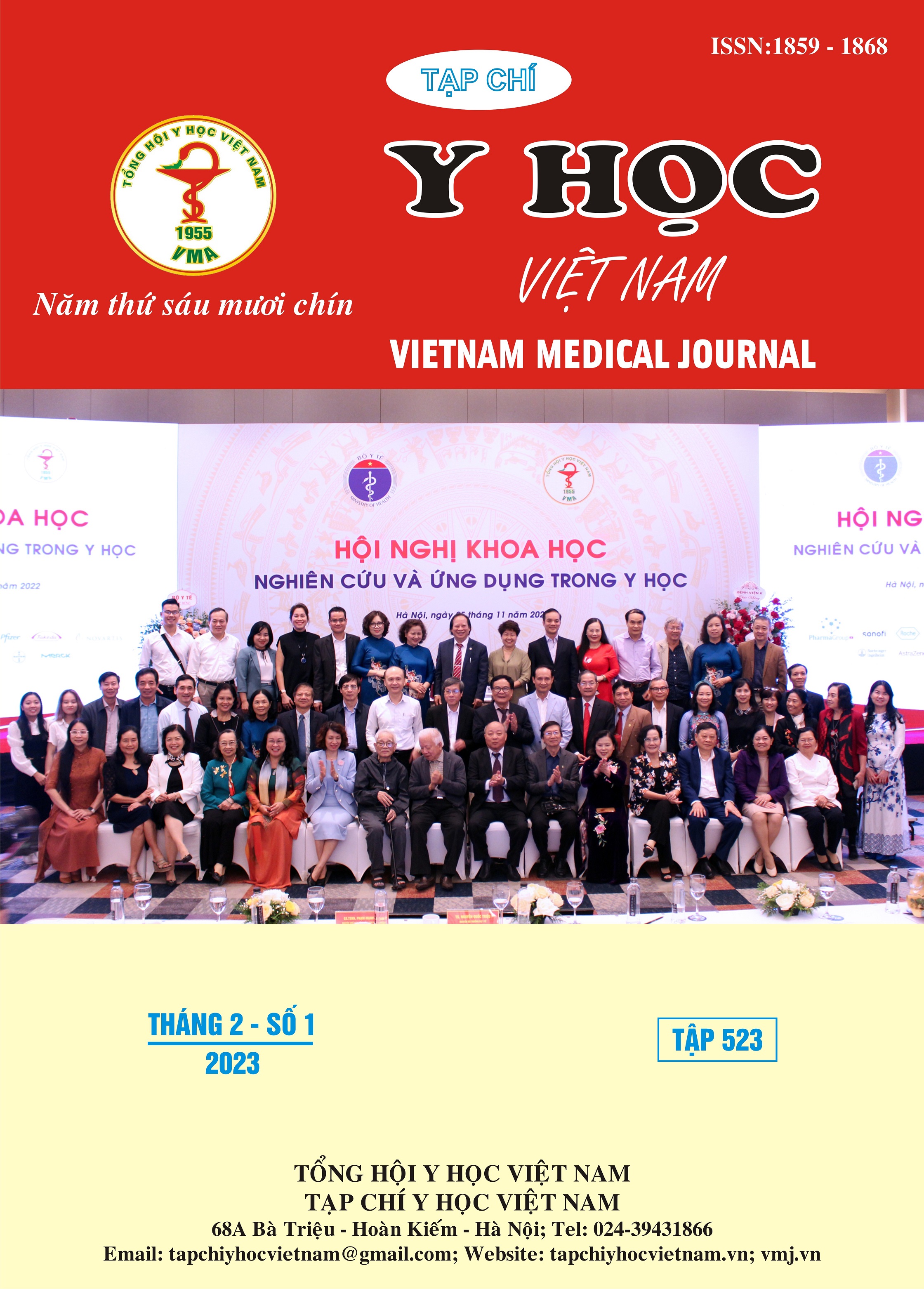EVALUATE THE OUTCOMES OF TREATMENT OF ACUTE LOWER EXTREMITY ISCHEMIA WITH FASCIOTOMY DUE TO WOUND TRAUMA AT VIET DUC UNIVERSITY HOSPITAL
Main Article Content
Abstract
Objectives: To observe the pathological characteristics and evaluate the outcomes of treatment of acute lower extremity ischemia with fasciotomy due to wound trauma at Viet Duc University Hospital. Method: A retrospective descriptive study with a none control group on 70 patients diagnosed with acute lower extremity ischemia who were revascularized with fasciotomy at Viet Duc University Hospital from January 2020 to December 2021. Result: In 70 studied patients, the male/female ratio = 1.8/1; the average age was 33.2 ± 13.2 years old. The main cause was traffic accidents accounting for 82.9%. Primary healthcare facilities were at the provincial level accounting for 82.9%. The prevalence of vessels damaged by trauma was 94.3%, and by wounds was 5.7%; the majority was popliteal artery accounting for 88.6%. 100% of patients were revascularized at more than 6 hours after the accident. The Rutherford classification IIa or higher accounts for 95.7%. There was no difference between preventative and treatment fasciotomy in males and females (p=0.141 > 0.05, Chi-Square Test). There 17.2% of patients needed to remove necrotic muscle after surgery. 10% had surgical wound bleeding complications; 24.3% had surgical wound inflammation. 5/70 patients with occlusion of the anastomosis required reoperation. 2/70 cases had to be amputated early after surgery due to muscle necrosis unrelated to fasciotomy. There were no cases of acute renal failure or death. The average time of fasciotomy closure is 13.84 ± 6.445 days, the earliest was 4 days, and the latest was 31 days. After 1 month of discharge, 82.4% of patients had limited mobility, 2.9% were immobile; only 48.5% of patients no longer feel pain after surgery. After 6 months, 33.8% of patients had limited mobility, no longer had to be immobile, and the prevalence of pain-free was 97.1%. Conclusion: The outcomes of treatment of acute lower extremity ischemia with fasciotomy due to wound trauma was quite good, influenced by the initial injury characteristics, wound care, and postoperative rehabilitation.
Article Details
Keywords
acute lower extremity ischemia, fasciotomy, lower extremity vascular injury.
References
2. Olinic D, Stanek A, Tătaru D, Homorodean C, et al. Acute limb ischemia: an update on diagnosis and management. J Clin Med. (2019) 8:1215-26 .10.3390/jcm8081215.
3. Patman RD, Thompson JE. Fasciotomy in peripheral vascular surgery: report of 164 patients. Arch Surg. 1970; 101: 663-672.
4. Rollins DL, Bernhard VM, Towne JB. Fasciotomy: an appraisal of controversial issues. Arch Surg. 1981; 116: 1474-1481.
5. Rush DS, Frame SB, Bell RM, et al. Does open fasciotomy contribute to morbidity and mortality after acute lower extremity ischemia and revascularization. J Vasc Surg. 1989;10:343–50.
6. Nguyễn Hữu Ước, Vũ Ngọc Tú. Chấn thương, vết thương động mạch chi. Bệnh học ngoại khoa tập 1, Nhà xuất bản Y học; 2020.
7. Kluckner, M., Gratl, A., Gruber, L., Frech, A., Gummerer, M., Enzmann, F. K., Wipper, S., & Klocker, J. (2021). Predictors for the need for fasciotomy after arterial vascular trauma of the lower extremity. Injury, 52(8), 2160–2165.
8. Đoàn Hữu Hoạt, Nguyễn Hữu Ước, Vũ Ngọc Tú (2019). Đặc điểm lâm sàng và thương tổn giải phẫu bệnh chấn thương động mạch chi dưới tại Bệnh viện Hữu nghị Việt Đức giai đoạn 2017-2019. Y học thực hành, 7 (1103), 38-42.
9. Đoàn Quốc Hưng, Nguyễn Văn Đại, Nguyễn Thế May (2017). Chấn thương, vết thương động mạch ngoại vi: Hình thái tổn thương và kết quả điều trị tại bệnh viện Việt Đức. Phẫu thuật Tim mạch và Lồng ngực Việt Nam. 16, 8-13.
10. Thang DN, Tu VN, Kien TT, Huu N. Kết quả phẫu thuật điều trị chấn thương động mạch khoeo do trật khớp gối tại bệnh viện hữu nghị Việt Đức. VJCTS. 2021;30:17-23. doi:10.47972/vjcts.v30i.470.


